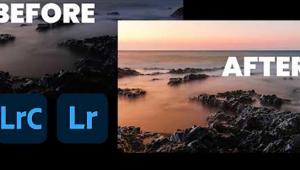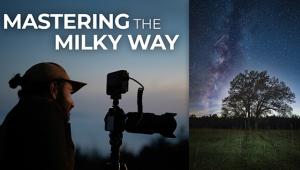Sony’s Alpha A100; A 10-Megapixel Digital SLR With Some Familiar Features Plus Sony Technology
The first digital SLR from Sony, the Alpha A100 ($899, body; $999 with 18-70mm
f/3.5-5.6 kit lens) offers amenities from the Konica Minolta Maxxum 5D along
with Sony technology. This first camera from the Konica Minolta/Sony collaboration
announced in 2005 employs the Alpha designation that was previously used for
the Maxxum line in Asia. More than a "re-badged Maxxum 5D," as some
pundits have claimed, the A100 boasts enhancements and more sophisticated technology.
In a nutshell, it's the next and more advanced generation of the (discontinued)
Konica Minolta digital SLRs.
Numerous Shutterbug readers have asked about compatibility with their Maxxum
systems and they'll be happy with the answer. The A100 employs the familiar
Maxxum mount, with extra reinforcement that's useful with very heavy lenses.
It's compatible with "nearly all" Maxxum lenses ever made,
as well as most third-party lenses in the appropriate mount. Note, too, that
this Sony camera accepts the Maxxum D-series flash units and the two latest
Maxxum Macro flash units, although Sony will not guarantee full compatibility.
This report is based on information provided by Sony during the A100 launch
press conference, as well as two days of shooting with a production-level camera.
After more extensive testing with a broader range of subject matter, plus a
new Sony flash unit, we'll publish a complete Test Report.
 |
Primary New Features
Resembling the 6-megapixel Maxxum 5D in general appearance, most menu items,
and some controls, the A100 employs different trim and accents. It retains the
best features of that camera, including the Eye-Start system that instantly
activates autofocus for quick response. New technology incorporated in the camera
includes:
· A 10.2-megapixel (effective) 23.6x15.8mm CCD sensor with a wide tonal
range and 3872x2592 pixel resolution. This sensor appears to be similar to the
(Sony-made) CCD used in the Nikon D200, although Sony reps declined to comment
on that issue.
· An entirely new BIONZ Image Processing Engine with algorithms to maximize
detail and color integrity and to minimize digital noise. This engine offers
fast processing for shooting an unlimited number of full-resolution JPEGs in
a single burst at 3 fps. (Naturally, the number of shots is limited by the amount
of available memory on the card.) That requires a very fast CompactFlash card
such as the Kingston 100x, SanDisk Extreme III, or Lexar Pro 133x. In raw capture,
at least eight frames can be taken in a single burst; again that depends on
the card in use.
· A unique Dynamic Range Optimizer feature, made possible with the BIONZ
engine. Three options are available: Off, Standard, and Advanced. Intended for
use in high contrast lighting--and especially in backlighting--the
Optimizer makes gamma and tonal adjustments for more pleasing pictures. The
Standard option analyzes the entire scene while the Advanced mode evaluates
1200 individual segments and makes local adjustments as you might in Photoshop
with the dodging and burning utility. In more practical terms, the system provides
increased shadow detail and slightly better highlight detail under high contrast
lighting.
· New methods to minimize dust on the sensor, including a special antistatic
coating (Indium Tin Oxide) on the low-pass filter to minimize static electricity
and an Anti-Dust system. The latter employs vibration (from the CCD-shift device)
to shake off loose dust particles at power off. According to a Sony rep, "The
shake is not as strong as with Olympus' Supersonic system but our coating
resists the attraction of dust particles."
· A 2.5" Clear Photo LCD monitor with 230,000 vs. 207,000 pixels
resolution, wide viewing angle, and new anti-reflection coating that makes the
display more visible in bright light.
· A superior Anti-Shake system--now called Super SteadyShot--that
moves the entire CCD sensor module to provide Image Stabilization with Maxxum
and Sony Alpha mount lenses. More effective in the low frequency camera shake
range, it's said to provide a "2-3.5 shutter speed advantage"
over non-stabilized cameras/lenses.
· A 40-segment (vs. 14) evaluative honeycomb metering pattern to increase
the odds of accurate exposure in difficult lighting/contrast conditions.
· A new "Long-Life Stamina" (1600 mAh lithium ion) battery
said to provide 750 shots on a single charge, assuming 50 percent flash usage
(CIPA standard). Do note that the A100 is not compatible with the battery used
by the Maxxum D bodies.
The Full System
By the end of 2006, Sony will be marketing 19 lenses and 34 accessories for
the Alpha system. The lenses include affordable to pro-caliber Sony G products
and the upscale Zeiss Alpha series, to be available starting in October. The
Zeiss lenses include the multi-platform 85mm f/1.4, 135mm f/1.8, and the "digital
only" 16-80mm f/3.5-4.5 zoom. The most professional Sony G lenses will
include the 70-200mm f/2.8G and the 300mm f/2.8G, both compatible with the 1.4x
and 2x converters. As you might expect, most of the Sony G series appear to
be re-badged Maxxum lenses with different styling and trim. Sony also showed
a range of accessories at the press conference: conventional flash units and
macro flash systems, various flash accessories, including those intended for
wired off-camera flash, remote controller units, angle finder, viewfinder magnifier,
external battery pack for flash units, and others. Based on the extensive system,
it's clear that the A100 is only the first in a full range of Alpha digital
SLRs, likely to include even faster "prosumer" models and a true
professional-caliber camera. The latter would make sense, since many news photographers
in Asia and Europe have been using the Konica Minolta "Dynax" or
"Alpha" (Maxxum) system.
Preliminary Assessment
Based on a couple of days of shooting, I cannot provide a full assessment of
the merits of this Sony camera, but I'll offer the following comments.
The A100 is much faster than average in terms of buffer clearing so it's
almost always ready to shoot another very long burst. The only minor drawback
is the 3 fps framing rate; it's quite competitive in the affordable price
range but some of the more expensive digital SLRs can shoot at a blazing 5 fps.
Autofocus is fast and reliable with static subjects, though a bit noisy. Shutter
and mirror noise (a clunk) is also higher than average. In Continuous AF, the
A100 is not as fast/reliable as the Nikon D70s with Silent Wave lenses or the
Digital Rebel XT with USM lenses. Hence, it's not as effective for tracking
the motion of very fast, erratically moving action subjects but that's
relevant only to serious sports photographers.
In other respects, the A100 is very competitive and its higher resolution, plus
built-in Image Stabilizer, give Sony an edge over the best-selling Nikon and
Canon models. Even so, some industry observers doubt that Sony can ever meet
its goal to capture a 10% share of the global digital SLR market. After all,
the A100 is more expensive and the Maxxum D models never gained more than a
niche following, they reason. On the other hand, the Alpha A100 is superior
to the Konica Minolta cameras and the market is expanding more rapidly today.
Tens of millions of additional families are expected to upgrade from compact
digicams. Most of those consumers have no SLR brand loyalty or any existing
lenses and the Sony brand name is a powerful draw. According to many studies,
it's definitely such upgraders who are responsible for the annual 25 percent
increase in digital SLR sales, a trend that's likely to continue until
2010.
Anyone who decides to buy an Alpha A100 should definitely be satisfied with
image quality. It's exceptional in the ISO 100-400 range, with very rich
(though believable) colors, high sharpness, and incredible definition of fine
detail, suitable for gallery quality 13x19" prints. The Dynamic Range
Optimizer improves photos made in ultrahigh contrast lighting but produces a
slightly over-processed effect. Thanks to the new sensor and processor, the
digital noise pattern is fine and tight at ISO 800 and colors remain rich. Noise
is problematic only at ISO 1600 where the mottled pattern obliterates ultra-fine
details; as well, color rendition in ISO 1600 images is flat and dull.
This is a beautifully finished, lightweight, surprisingly compact, well-balanced
camera with magnesium-alloy chassis and stainless-steel lens mount. Designed
for convenient operation, it's equipped with logical, well marked controls,
a menu with convenient navigation, and an ergonomically-designed handgrip. As
the full list of Specifications (available in our Instant Links section on the
Shutterbug website) indicate, it's also remarkably versatile. In long-term
use, I would miss only reflex mirror lockup to eliminate internal vibrations
in high-magnification macro photography. Although owners of Maxxum systems have
long awaited a compatible Sony digital SLR, the Alpha A100 and accessories should
also attract many "upgraders" as well as some serious photo enthusiasts.
- Log in or register to post comments

































